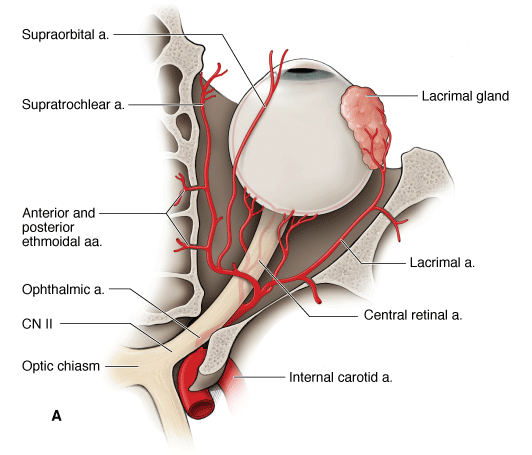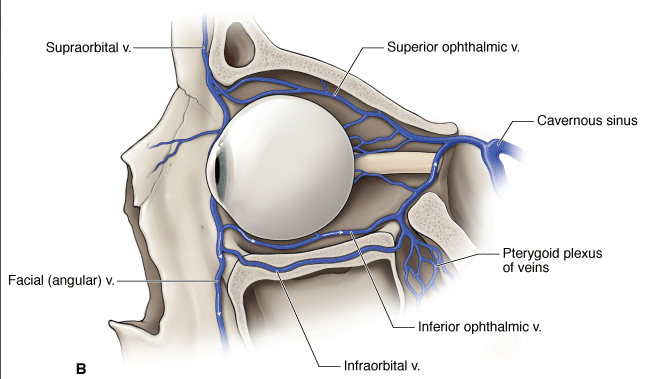Big Picture
The ophthalmic artery provides the principal vascular supply to the orbit. The superior and inferior ophthalmic veins drain anteriorly to the facial vein, posteriorly to the cavernous sinus, and inferiorly to the pterygoid plexus.
The ophthalmic artery enters the orbit through the optic canal with CN II (Figure 18-5A). 

A. Arteries of the orbit. B. Veins of the orbit.
Branches travel to the eye, lacrimal gland, eyelids, scalp, extraocular muscles, and the side of the nose. Major branches of the ophthalmic arteries are as follows:
- Central retinal artery. Travels within CN II and at the optic disc sends numerous branches to the retina. The central artery of the retina is the most important branch of the ophthalmic artery because it supplies all the nerve fibers of CN II. Therefore, if the central artery is occluded, there is complete loss of vision in that eye.
- Posterior ethmoidal artery. Courses through the posterior ethmoidal foramen and provides vascular supply to the ethmoid sinus.
- Anterior ethmoidal artery. Courses through the anterior ethmoidal foramen and provides vascular supply to the ethmoid sinus, frontal sinus, nasal cavity, and the external part of the nose.
Ophthalmic Veins
The principal veins that drain the orbit are the superior and inferior ophthalmic veins (Figure 18-5B).
- Superior ophthalmic vein. Formed by the union of the supraorbital, supratrochlear, and angular (facial) veins and communicates posteriorly with the cavernous sinus. The superior ophthalmic vein may also receive tributaries from the inferior ophthalmic vein. Unlike most other veins, the superior ophthalmic vein lacks valves and, therefore, blood may drain anteriorly through the angular vein or posteriorly in the cavernous sinus.
 The medial angle of the eye, nose, and lips is a triangular area of potential danger in the face. The blood in this region usually drains inferiorly via the facial vein. However, blood can also drain superiorly through the facial vein to the superior ophthalmic vein to the cavernous sinus. Therefore, an infection of the face may spread to the cavernous sinus and pterygoid plexus.
The medial angle of the eye, nose, and lips is a triangular area of potential danger in the face. The blood in this region usually drains inferiorly via the facial vein. However, blood can also drain superiorly through the facial vein to the superior ophthalmic vein to the cavernous sinus. Therefore, an infection of the face may spread to the cavernous sinus and pterygoid plexus.
- Inferior ophthalmic vein. Communicates with the pterygoid plexus of veins through the infraorbital fissure, as well as with the infraorbital vein. The inferior ophthalmic vein terminates in the cavernous sinus.